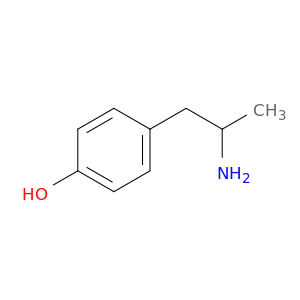
Phenol,4-(2-aminopropyl)-
| Title | Journal |
|---|---|
| Bladder selectivity of the novel β₃-agonist ritobegron (KUC-7483) explored by in vitro and in vivo studies in the rat. | Naunyn-Schmiedeberg's archives of pharmacology 20120801 |
| Functional investigation of β-adrenoceptors in human isolated detrusor focusing on the novel selective β3-adrenoceptor agonist KUC-7322. | Naunyn-Schmiedeberg's archives of pharmacology 20120801 |
| Effects of ritobegron (KUC-7483), a novel selective β3-adrenoceptor agonist, on bladder function in cynomolgus monkey. | The Journal of pharmacology and experimental therapeutics 20120701 |
| Opposing efficacy of group III mGlu receptor activators, LSP1-2111 and AMN082, in animal models of positive symptoms of schizophrenia. | Psychopharmacology 20120401 |
| Trace amine-associated receptor 1 is a stereoselective binding site for compounds in the amphetamine class. | Bioorganic & medicinal chemistry 20111201 |
| p-Hydroxyamphetamine causes prepulse inhibition disruption in mice: contribution of serotonin neurotransmission. | Behavioural brain research 20111010 |
| The melanin-concentrating hormone (MCH) system modulates behaviors associated with psychiatric disorders. | PloS one 20110101 |
| p-Hydroxyamphetamine causes prepulse inhibition disruptions in mice: contribution of dopamine neurotransmission. | Behavioural brain research 20101225 |
| New meconium biomarkers of prenatal methamphetamine exposure increase identification of affected neonates. | Clinical chemistry 20100501 |
| Central administration of p-hydroxyamphetamine produces a behavioral stimulant effect in rodents: evidence for the involvement of dopaminergic systems. | Psychopharmacology 20100201 |
| Current pharmacologic testing for Horner syndrome. | Current neurology and neuroscience reports 20090901 |
| Novel biomarkers of prenatal methamphetamine exposure in human meconium. | Therapeutic drug monitoring 20090201 |
| Tyramine fragment binding to BACE-1. | Bioorganic & medicinal chemistry letters 20080215 |
| Trace amine-associated receptor 1 displays species-dependent stereoselectivity for isomers of methamphetamine, amphetamine, and para-hydroxyamphetamine. | The Journal of pharmacology and experimental therapeutics 20070401 |
| Determination of amphetamine, methamphetamine, and hydroxyamphetamine derivatives in urine by gas chromatography-mass spectrometry and its relation to CYP2D6 phenotype of drug users. | Journal of analytical toxicology 20070101 |
| Cation-selective exhaustive injection and sweeping MEKC for direct analysis of methamphetamine and its metabolites in urine. | Electrophoresis 20061201 |
| A study of the metabolism of methamphetamine and 4-bromo-2,5-dimethoxyphenethylamine (2C-B) in isolated rat hepatocytes. | Forensic science international 20050310 |
| Prolactinoma presenting as painful postganglionic Horner syndrome. | Neurology 20040427 |
| The correlation of phenylephrine 1% with hydroxyamphetamine 1% in Horner's syndrome. | The British journal of ophthalmology 20040401 |
| Simultaneous determination of amphetamine derivatives in human urine after SPE extraction and HPLC-UV analysis. | Biomedical chromatography : BMC 20040301 |
| Monoamine oxidase and head-twitch response in mice. Mechanisms of alpha-methylated substrate derivatives. | Neurotoxicology 20040101 |
| Horner syndrome. | Current opinion in ophthalmology 20031201 |
| Screening for and validated quantification of amphetamines and of amphetamine- and piperazine-derived designer drugs in human blood plasma by gas chromatography/mass spectrometry. | Journal of mass spectrometry : JMS 20030601 |
| False negative hydroxyamphetamine test in horner syndrome caused by acute internal carotid artery dissection. | Journal of neuro-ophthalmology : the official journal of the North American Neuro-Ophthalmology Society 20030301 |
| The contribution of the metabolite p-hydroxyamphetamine to the central actions of p-methoxyamphetamine. | Psychopharmacology 20020301 |
| Determination of amphetamine and its metabolite p-hydroxyamphetamine in rat urine by reversed-phase high-performance liquid chromatography after dabsyl derivatization. | Biomedical chromatography : BMC 20011101 |
| Hydroxyamphetamine drops for Horner's syndrome. | Canadian journal of ophthalmology. Journal canadien d'ophtalmologie 20010801 |
| Hydroxyamphetamine increases intraocular pressure in rabbits. | Archives of ophthalmology (Chicago, Ill. : 1960) 20010201 |
| Simultaneous determination of methamphetamine and its metabolites in monkey urine by gas chromatography/mass spectrometry with selected ion monitoring. | Journal of analytical toxicology 19890101 |